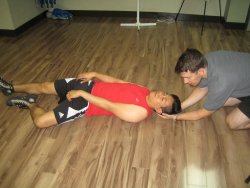
Caused due to low blood pressure, fainting is a kind of unconsciousness. It is quick and brief and can be a result of a more serious underlying medical condition. An unconscious person cannot cough, clear his thoughts or turn his head if in distress. There is a danger of choking in a person who has fainted, so it is imperative to make sure that the airway of the person is clear till medical care is sought.
Conditions such as orthostatic hypotension (the drop in blood pressure due to standing too promptly), hypoglycemia, hunger, dehydration, anxiety or panic or heart disorders may cause fainting.
Certain medications may be associated with fainting, such as blood pressure medications, diabetes medications and allergy medications.
The material posted on this page on this page on managing fainting and circulatory emergencies is for learning purposes only. To learn to effectively manage breathing and circulatory emergencies sign up for standard or emergency first aid training.
First Aid Guide
The following self-care measures are suggested in the event of fainting:
- Try and prevent someone who is fainting from hitting the ground.
- Lay the person down on the ground, with his face up and elevate her feet 8-12 inches above the body.
- In case the person is wearing constrictive clothing, loosen them up.
- Apply cool and wet compresses to the fainted person’s forehead.
- Don’t let the person to stand up until he is fully recovered.
There are a few other things to keep in mind while taking care of an unconscious person:
- In case the person vomits, turn him quickly to allow the fluid to drain out without blocking the person’s airways.
- Don’t feed the unconscious person with anything via mouth.
- Don’t shake or slap the unconscious person in an attempt to help him regain consciousness.
- In case a person is injured while fainting, first provide him with the first aid needs. If he is bleeding, you can stop the blood by direct pressure.
Who’s At Risk?
There are certain medical conditions which increases the risk of fainting in people. Low blood sugar, anemia, heart and circulatory problems, toxic shock syndrome, etc. are some conditions in which the risk of fainting increases. In fact, if people stand in one place in high heat for a long time, they might faint. Sudden stress, fright, pain, etc. are also known to make a person faint.
Signs and Symptoms
A person the verge of fainting experiences dizziness, nausea, weakness or blurred vision before fainting. A fainted person might look pale, clammy and might turn cold if unconscious for long. An unconscious person might look disoriented, incoherent and silent for a whole even after regaining consciousness.
In case, the person doesn’t regain consciousness within 5 minutes, is elderly, or has a medical problem, seek emergency medical help immediately. In case the fainting is suspected due to an underlying condition, seek treatment by a medical professional and determine the cause. After diagnosis, the doctor can advise you to get appropriate treatment done.
